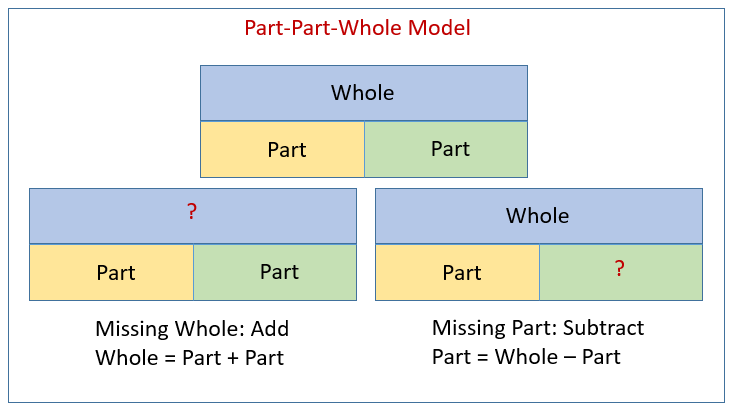Part-Part-Whole Word Problems
In this lesson, we will learn how to solve part-whole (or part-part-whole) word problems using either the part-part-whole diagram or bar models.
Related Pages
Addition & Subtraction Word
Multiplication and Division Word Problems
2-Step Word Problems and Bar Models
More Word Problems
Part–Part–Whole Word Problems
Part-Part-Whole word problems describe situations where a whole is made up of two or more parts. The problems typically give information about some of these parts and the whole, or about the relationship between the parts, and ask you to find a missing part or the missing whole.
We will look at two types of part-part-whole word problems: Missing Whole or Missing Part.
The following diagrams show the Part-Part-Whole Models to find the Missing Whole or Missing Part. Scroll down the page for examples and solutions.

Missing Whole or Whole Unknown
You are given the values of two or more parts, and you need to find the total value of the whole.
For example: Connie has 15 red marbles and 28 blue marbles. How many marbles
does she have?
We are given the parts and we need to find the whole.
This would involve addition.
15 + 28 = 43
Missing Part or Part Unknown
You are given the value of the whole and the value of one or more parts, and you need to find the value of the remaining part(s)
For example: Connie has 43 marbles. 15 are red and the rest are blue. How many
blue marbles does Connie have?
We are given the whole and we need to find the part. This would involve subtraction.
43 - 15 = 28
Using Part-Part-Whole Diagram To Solve Word Problems
Everyday Math Parts-and-Total number stories
- Read it.
- Think about it.
- What’s this problem asking? - Plan it.
- Do it.
- Check it.
Example:
For each problem, write ? for the number you want to find. Write the number you know in the diagram.
Then write the answer and a number model. Finally, write how you know that each answer makes sense.
- Marisa read her book for 25 minutes on Monday and 30 minutes on Tuesday. How many minutes in all did she read?
How To Solve Parts-And-Total Number Stories?
Example:
An alligator clutch had 60 eggs. Only 12 hatch. How many eggs did not hatch?
How To Solve Part-Part-Whole Word Problems?
This video demonstrates how to solve a word problem using the “Part-Part-Whole” strategy or Part-Part-Whole box.
Example:
Westfield Elementary has 153 tickets to sell for the school musical. After one day of selling tickets,
there were 79 tickets left. Which operation could be used to find how many tickets were sold on the
first day?
How To Use Model Drawing To Solve Part-Part-Whole Word Problems?
Examples:
- A school earns $423 from a bake sale in August and $2,750 from a cookie dough fund raiser in November. How much money did the school earn during the school year?
- An auditor reviewed 924 tax documents from the previous tax season. 754 of these documents were filed correctly. How many documents were filed incorrectly and need to be audited?
- The Keebler elves are busy making cookies. So far, they’ve made 9,872 cookies. They have 4,258 fudge stripes, 2.294 rainbow cookies and some animal crackers. How many animal crackers have they made?
Using Bar Models To Solve Part-Whole Word Problems
This video shows you how to solve a word problem using bar models. This technique is one of the strategies that can be used to address Common Core math standard 2.OA.1. Bar Models are also used in Singapore Math.
Example:
Maya had some stamps. She gave 7 stamps to her younger brothers. Maya then had 14 stamps. How many
stamps did Maya have at first?
Word Problems 1 - Bar Model (Part-Whole)
This video introduces a visual way to solve world problems using bar modeling. This type of word problem uses the part-whole model.
Because the part is missing, this is a subtraction problem.
An effective model always has a visual model of the problem, a number sentence, and the answer to the question in a complete sentence.
Example:
Mr. Oliver bought 88 pencils. he sold 26 of them. How many pencils did he have left?
Word Problems 2 - Bar Model (Part-Whole)
This video employs a visual way to solve world problems using bar modeling. This type of word problem uses the part-whole model. Because the part is missing, this is a subtraction problem.
Example:
There are 98 hats, 20 of them are pink and the rest are yellow. How many yellow hats are there?
Word Problems 3 - Bar Model (Part-Whole)
This video employs a visual way to solve world problems using bar modeling. This type of word problem uses the part-whole model. Because the whole is missing, this is an addition problem.
Example:
Mr. Gray sold 64 drinks in the morning. Mr. Frank sold 25 drinks at night. How many drinks did they
sell altogether?
Try out our new and fun Fraction Concoction Game.
Add and subtract fractions to make exciting fraction concoctions following a recipe. There are four levels of difficulty: Easy, medium, hard and insane. Practice the basics of fraction addition and subtraction or challenge yourself with the insane level.

We welcome your feedback, comments and questions about this site or page. Please submit your feedback or enquiries via our Feedback page.